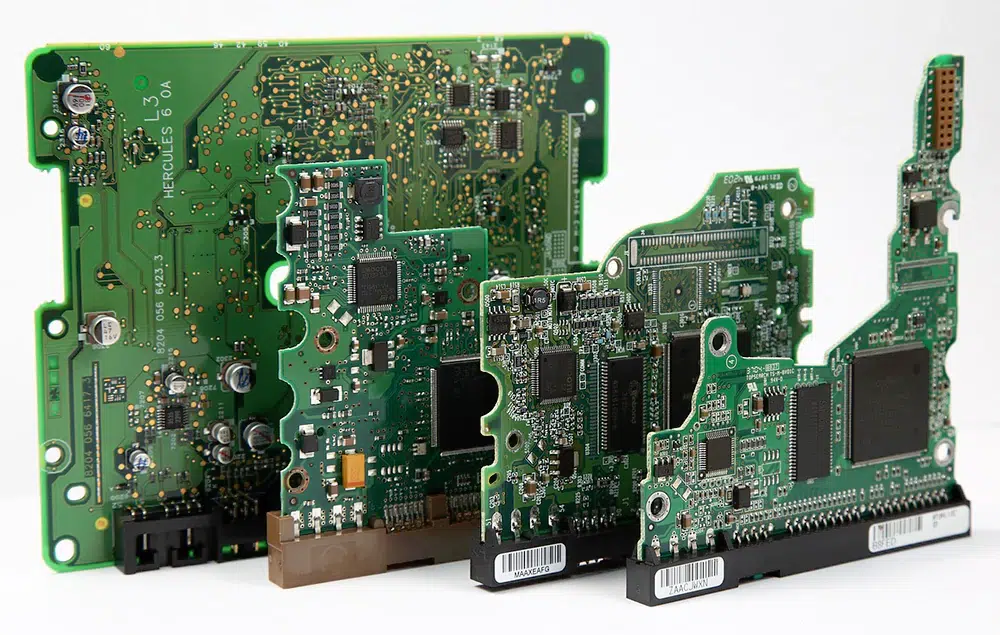Selecting the right thickness for your printed circuit board (PCB) is crucial for ensuring its performance, reliability, and manufacturability. PCB thickness affects not only the physical and mechanical properties of the board but also its electrical characteristics. This guide explores the key factors influencing PCB board thickness and provides practical tips for making an informed decision.
Understanding PCB board thickness
PCB board thickness is typically measured in fractions of an inch or millimeters. The most common thicknesses range from 0.8 mm (approximately 0.031 inches) to 2.0 mm (about 0.079 inches). However, thicker and thinner boards are available to accommodate various design requirements.

Key factors influencing PCB board thickness
1. Mechanical Strength and Durability
– Application Requirements: Thicker PCBs generally offer greater mechanical strength and durability. This is crucial for applications subject to physical stress, vibration, or heavy components. For instance, automotive or industrial PCBs might require thicker boards to withstand harsh conditions.
– Handling and Assembly: Thicker PCBs are less likely to flex or bend during handling and assembly, reducing the risk of damage to the board or components. This can be important for boards that will be subjected to rigorous assembly processes.
2. Thermal Management
– Heat Dissipation: The thickness of the PCB can impact heat dissipation. Thicker boards can offer better heat sinking capabilities, which is essential for high-power applications or components that generate significant heat. For instance, if your design includes high-power LEDs or processors, you might need a thicker PCB to manage thermal issues effectively.
– Copper Thickness: In addition to overall board thickness, the thickness of the copper layers (measured in ounces per square foot) also plays a role in heat dissipation. Thicker copper layers can help spread heat more effectively, complementing the benefits of a thicker board.
3. Signal Integrity
– Electrical Performance: The PCB board thickness can influence signal integrity and performance. Thicker boards might introduce more capacitance and affect the impedance of high-speed signals. In high-frequency or high-speed applications, careful consideration of PCB board thickness is necessary to maintain signal quality.
– Trace Routing: The thickness of the board affects the available space for routing traces. In densely packed designs, thicker boards might offer more flexibility in routing complex circuits, although this must be balanced against other factors such as cost and space constraints.
4. Manufacturing Considerations
– Cost: Thicker PCBs can be more expensive to manufacture and may also increase the overall weight of the product. For large production runs, the cost implications of choosing a thicker board should be carefully evaluated.
– Standardization: Many PCB manufacturers have standard thicknesses that are more cost-effective and readily available. Choosing a standard thickness can simplify the manufacturing process and reduce costs.
5. Environmental Conditions
– Temperature Extremes: For applications exposed to extreme temperatures, thicker PCBs might offer better stability and reliability. However, it’s essential to balance this with other factors such as thermal expansion and contraction, which can affect the board’s performance.
– Moisture and Chemical Exposure: In environments with high humidity or exposure to chemicals, the PCB’s thickness, combined with proper coating and encapsulation, can impact its longevity and reliability.
Practical tips for selecting PCB board thickness

– Begin by evaluating the specific needs of your application, including mechanical, thermal, and electrical requirements. Consider factors such as the environment in which the PCB will operate, the types of components used, and any potential mechanical stresses.
2. Consult with Your PCB Manufacturer
– Work closely with your PCB manufacturer to understand their capabilities and recommendations. Manufacturers can provide valuable insights into the best thickness for your design, taking into account their equipment and processes.
3. Evaluate Cost vs. Performance
– Balance the benefits of a thicker PCB with cost considerations. While thicker boards offer enhanced mechanical strength and thermal management, they can also be more expensive. Consider whether the added performance justifies the additional cost.
4. Consider Industry Standards
– Adhering to industry standards and guidelines can simplify the design process and ensure compatibility with other components and systems. Many industries have specific recommendations for PCB board thickness based on typical applications and performance requirements.
5. Prototype and Test
– Before finalizing your design, create prototypes and conduct thorough testing. Prototyping allows you to evaluate the performance of different thicknesses in real-world conditions and make adjustments as needed.
6. Stay Flexible
– Be prepared to make adjustments based on testing results and feedback from manufacturing partners. PCB design is often an iterative process, and flexibility can help you achieve the optimal balance of performance, cost, and manufacturability.
Conclusion
Selecting the right PCB board thickness is a critical decision that impacts the performance, reliability, and cost of your electronic product. By carefully considering factors such as mechanical strength, thermal management, signal integrity, manufacturing considerations, and environmental conditions, you can make an informed choice that meets the needs of your application. Collaboration with your PCB manufacturer and thorough prototyping will further ensure that you achieve the best possible results for your design.










